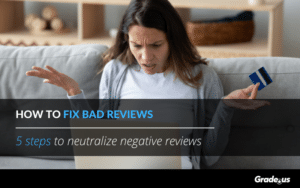Is it possible?
Can you increase your revenue by teaching customers to write reviews?
It sounds ridiculous.
But what does the data say? A Womply study of more than 200K businesses confirms this. They found that “Businesses with more reviews (than the average) across sites generate 54% more revenue. Businesses that respond to reviews average 35% more revenue.”
That’s 89% more revenue!
If you’re a regular reader, you know how to request, monitor, manage, and promote reviews. But what about training customers to write a review?
Is that possible?
As you’ll soon see, it’s a straightforward process you can use to boost revenue on demand.
Why your customers need you to train them
Research shows that 70% of customers will leave a review for your business if asked. This is great news, but it comes with a hidden caveat. These customers are willing to write a review for your business, but it doesn’t mean they will. We also don’t know if their reviews are positive or negative.
These are obvious problems.
There’s a hidden problem, though. Your customers may not know what to say. In fact, it’s likely that a large number of customers may ghost your review requests simply because they’re unsure about what to say and too embarrassed to admit it.
They’ll never tell you.
Another subset of customers may feel that it will take a lot of time to sit down and think about what to say, how to say it, or where to post it.
Training fixes all of this.
When you train your customers to write reviews on your behalf, this resolves all of these problems. Your customers receive the direction and clarity they need to create an exceptional review.
Telling customers what to say in your reviews is dishonest
It’s immoral and unethical, and the potential for blowback is huge.
That’s not what we’re doing.
When you train your customers to write a review on your behalf, you’re not placing restrictions on them. There are no expectations, demands, or incentives of any kind. You’re not ‘gently’ implying that customers give you a positive review either.
You’re giving them a framework.
This framework gives them the clear direction they need to tell their story. For better or worse, you’re helping them share their experience.
How’s this possible?
By asking your customers questions. The late Clayton Christensen was a professor at Harvard Business School and bestselling author of the book, The Innovator’s Dilemma. Here’s what he had to say about questions.
“Questions are places in your mind where answers fit. If you haven’t asked the question, the answer has nowhere to go. It hits your mind and bounces right off. You have to ask the question — you have to want to know — in order to open up the space for the answer to fit.”
Asking your customers questions creates a place for your customer’s answers. These questions, when structured properly and delivered at the right time, these questions give your customers deeper insights into their feelings.
It provides a strong frame for your request.
Instead of you requesting a review and approaching your customers as a pest, someone who’s asking for more assistance, you can approach them as a concerned provider.
Which questions motivate customers to write reviews?
These questions are a mix of open-ended and closed-ended questions. They’re intended to draw out the emotions buried in your customer’s subconscious.
Let’s take a look at a few of these questions.
- Did we make you happy?
- What was the worst part about your experience with us?
- Do you feel we took good care of you today?
- What would have prevented you from buying?
- What did you find as a result of buying this?
- Did any of our employees make your visit unpleasant?
- What’s the one thing you’d like us to change?
- Did we fix the problem that brought you into our store today?
- How long did you have to wait before someone offered to help you?
- What was the scariest part about working with us? How did you feel after working with us?
- What did you like most about our product (or service)?
- What would be three other benefits to this product (or service)?
- What were some of your biggest objections to buying this product (or service)?
- What area of our business needs improvement?
- Would you recommend us to someone else? Why?
Asking customers about these issues frames the conversation as ‘self-improvement,’ you’re looking for ways to serve them better in the future.
Compare that with review requests like these.
‘Can you write a review for us? We’d really appreciate it.’
Am I saying these review requests are bad?
Absolutely not.
There’s a time and place for these requests. But training your customers to respond to these kinds of requests, means you can pick any number of these questions (1 – 3 at a time) and go back to your customers again and again. This is how you get multiple reviews from a single customer across different platforms (e.g., Yelp, TripAdvisor, Google, etc.).
What would this look like in a review request?
[Customer Name],
Thank you for everything.
You took a risk on us, you purchased our [product] and supported us when we were just getting started.
It means so much.
I have a question for you. Did we make you happy? Was [product] what you expected, or did you feel like something was missing? I want to know if we’ve dropped the ball at all on this.
Please be honest, we can take it.
You’ve been with us from the beginning, so your thoughts on this carry a lot of weight. I want to ensure you’re happy with [product] because if you’re happy, we’re happy.
Best,
[Signature]
If you wanted a shorter version, you could go with something like this:
[Customer Name],
I have a quick question for you.
Did we make you happy?
Was [product] what you expected, or did you feel like something was missing? I want to know if we’ve dropped the ball at all on this.
Please be honest, we can take it.
[Signature]
You see my point though, right?
When you use questions to earn customer feedback, you receive in-depth answers in return. Customers see that you’re truly interested in their opinion, that you care about making things better for them.
‘But I don’t want their feedback!’
Why not?
Because my customers will write a negative review for my business!
Why you should train customers to write negative reviews
Here’s some surprising research from Womply.
“Businesses whose total number of reviews are 15-20% negative average 13% more in annual revenue than businesses whose reviews are only 5-10% negative! In other words, businesses with a higher ratio of bad reviews actually make more money, to a point. The optimal ratio of negative reviews is 10-25%.
When customers browse business listings on review sites, they expect to see a certain amount of bad reviews. In fact, many users skip past all positive reviews to read the first negative review they can find. And a business profile with little to no negative reviews may look untested or even suspiciously guilty of buying fake reviews.”
Whoa, that’s different.
It’s almost as if customers realize that nobody’s perfect! Did you see their point about all of this? Customers skip past all of the positive reviews, reading the negative reviews first!
Customers view brands with all-positive reviews as suspicious. Yeah, but too many negative reviews are a bad thing. I’ll start to impact your sales, revenue, and the business as a whole.
It’s true, negative reviews will do that.
But how many negative reviews is too much? If we look at the same study, we see that:
“Businesses whose reviews are 35-50% negative still earn close to the same as the average business.”
You’ve got a significant amount of leeway here.
The important point in all of this is the fact that authenticity is what counts. Generally speaking, customers are reasonable people; they know when a reviewer is being unfair. They see toxic customers, and they discount their reviews.
You can increase your revenue by teaching customers to write reviews
As we’ve seen, “Businesses with more reviews (than the average) across sites generate 54% more revenue. Businesses that respond to reviews average 35% more revenue.”
That’s 89% more revenue!
When you train your customers to write a review on your behalf, you’re not placing restrictions on them. There are no expectations, demands, or incentives of any kind. You’re not ‘gently’ implying that customers give you a positive review either.
You’re asking the right questions.
Your questions open a place in your customer’s mind. When structured properly and delivered at the right time, these questions give your customers deeper insights into their feelings. These thoughts and feelings translate to high quality reviews you can use to boost revenue, one customer at a time.










